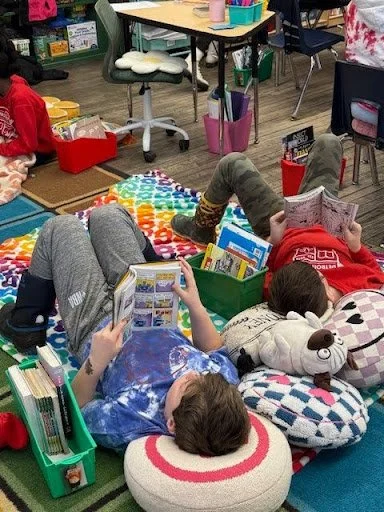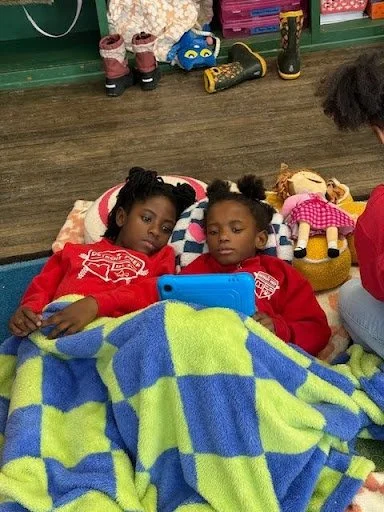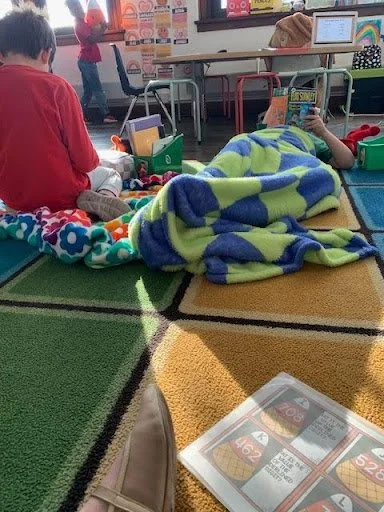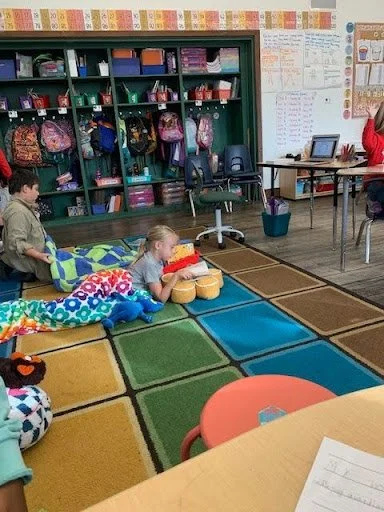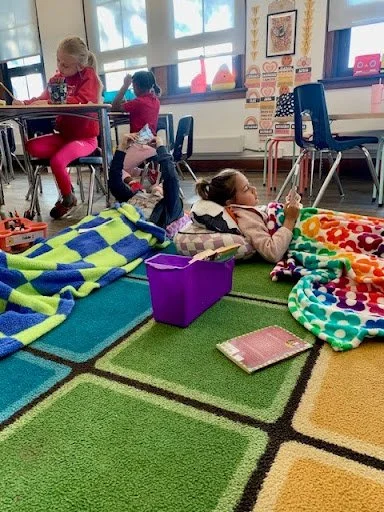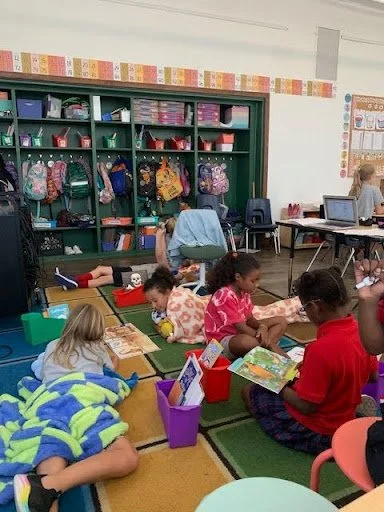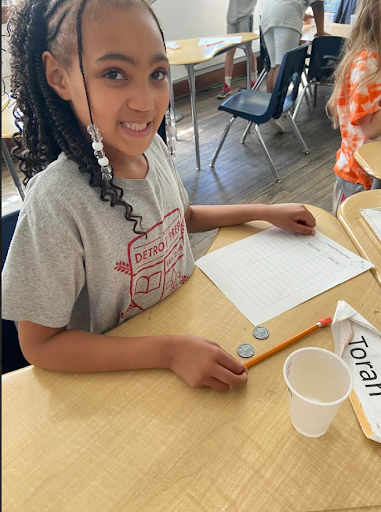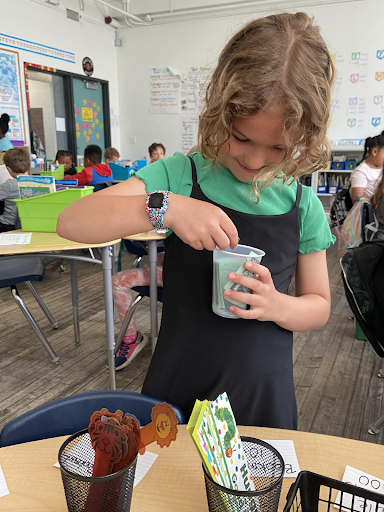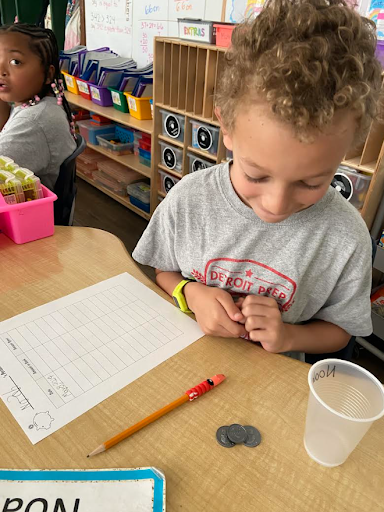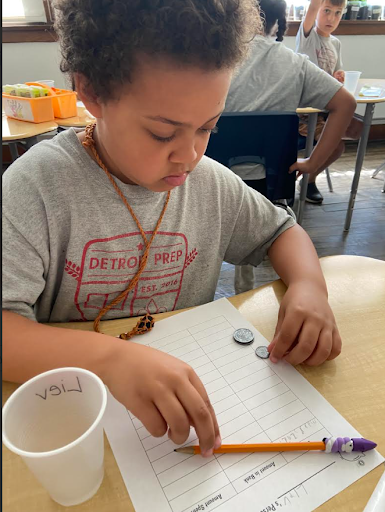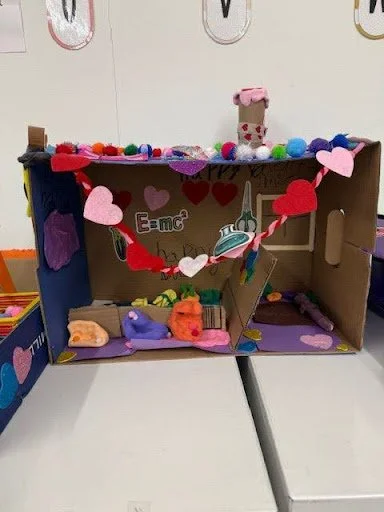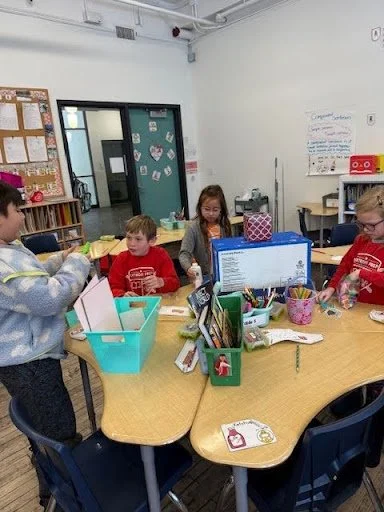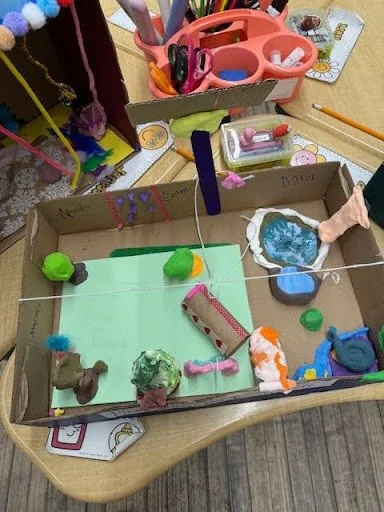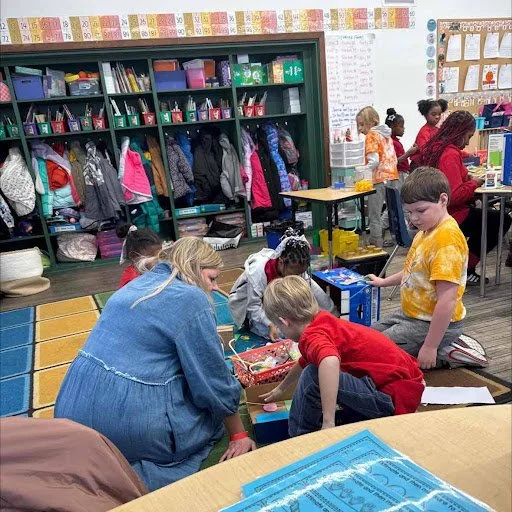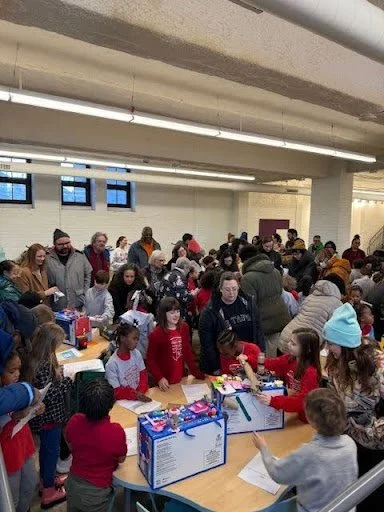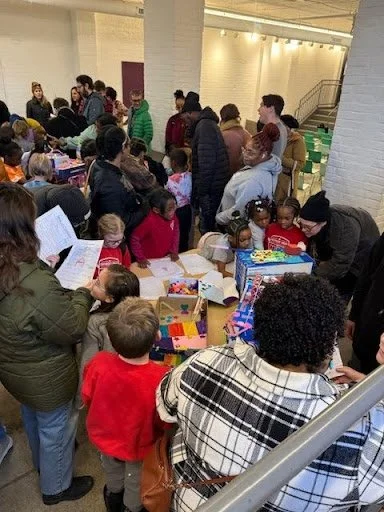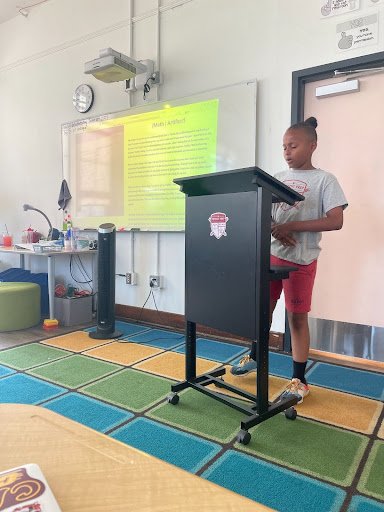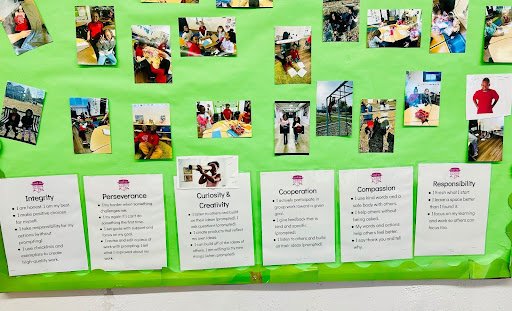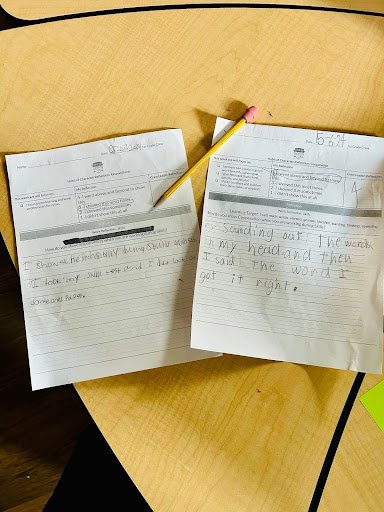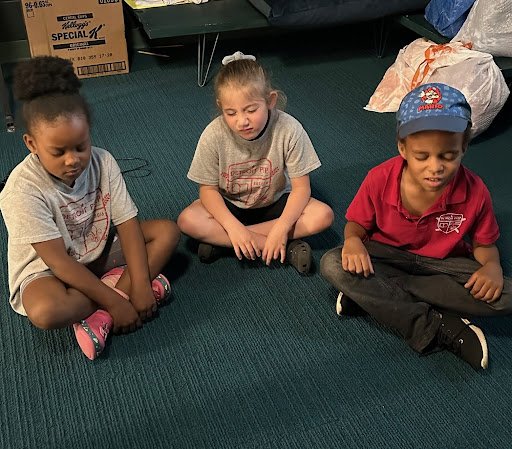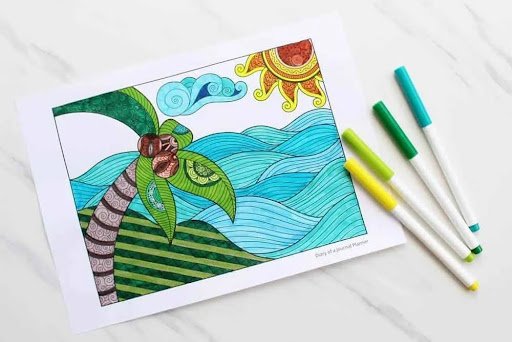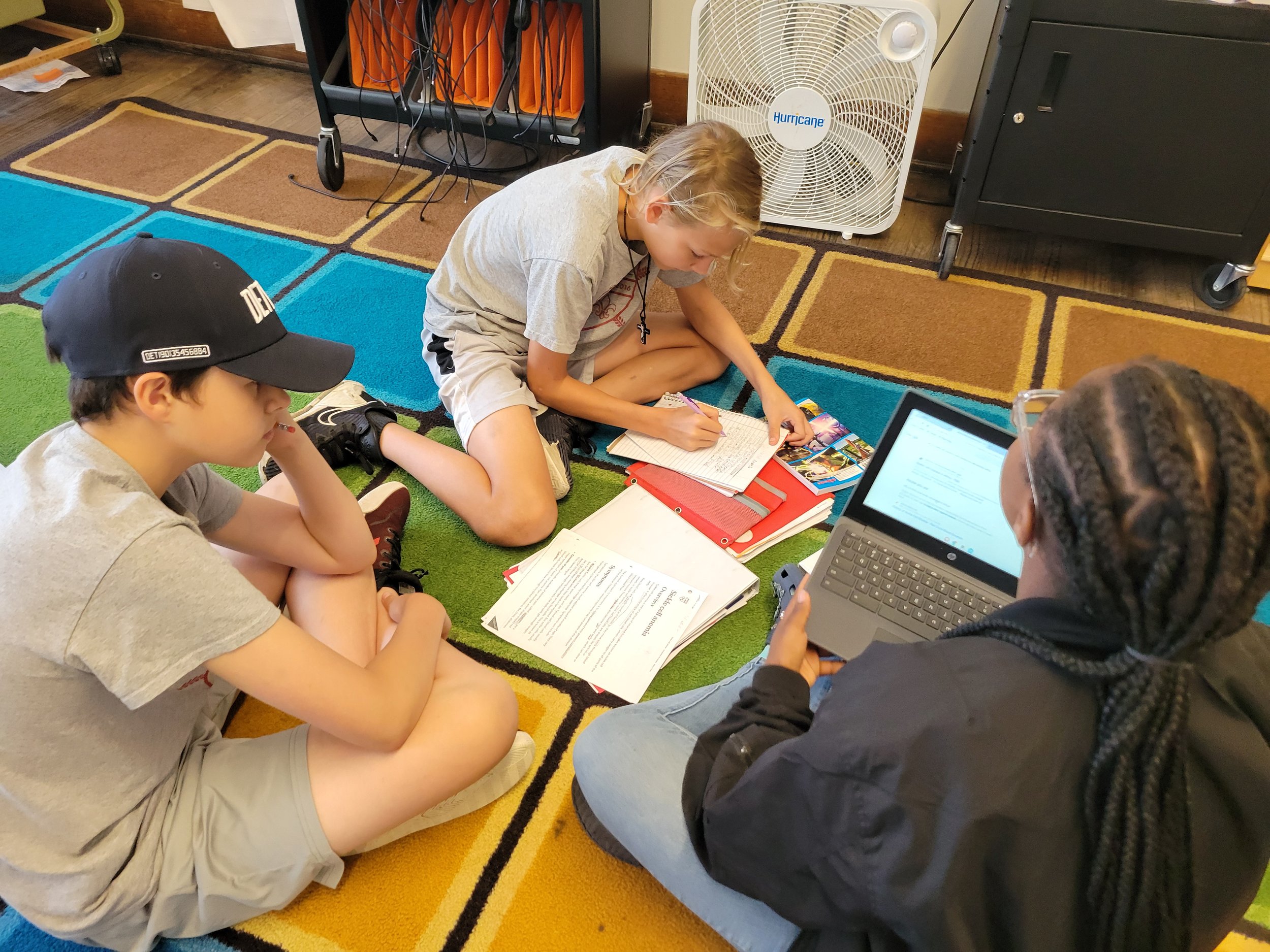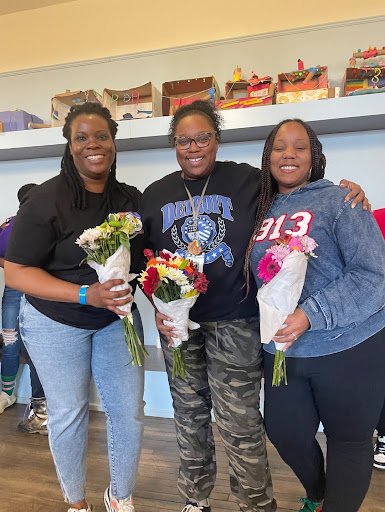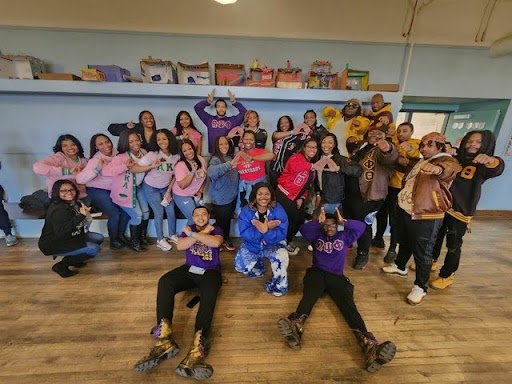Blog
Cozy Independent Reading
Cozy Independent Reading
What is your favorite way to read a book? If you are like me, I like to sit on the couch with a soft blanket, a hot cup of coffee, and a big pillow (or dog!). I like there to be quiet classical music playing softly in the background. I like to have the lights dim and then I am in the reading zone.
I wanted to try to recreate as many of those attributes as possible for the students. I know they can not have every part (sorry dogs!), but they can have some. That is why I was so excited when I learned that every day students had a time to independently read in the classroom.
Ms. Rebecca has created a wonderful small group/independent work daily schedule. After a whole group skills lesson, students are given a to-do list of three to four tasks. When students complete the first few tasks, which are connected to the skills lesson as independent work, as well as a weekly cursive letter, they are allowed to independently read a book of their choice.
The daily to-do list (Thanks again, Ms. Rebecca!) includes the group of students who are invited to the front of the classroom to read that day. The kids love to read on the rug and stretch out. To make their reading experience more enjoyable and comfortable, I brought in a few pillows, blankets and stuffed animals. They are allowed to take any of those items and read quietly on the rug until our skills time is finished. Also the stuffed animals are actually book characters from various books like The Diary of a Wimpy Kid, or Pete the Cat. The students enjoy placing a stuffed animal in their lap while they read. Some like to place it next to them like the stuffed animal is also reading. I also play light music in the background without words and dim the lights and let our large windows with beautiful natural light do their magic.
When skills is finished the students on the rug for that day quietly fold the blankets and put the other items away and then return to their seats. I was excited to see how much the students enjoyed the cozy independent read time. I think the reading on the rug is fun and also reminds students that reading feels good. It makes them feel calm, happy, and excited to keep reading. I plan to keep making reading feel fun, and always cozy.
Money Skills 101
Money Skills 101
The concept of money looks very different for children being raised in the 2020s. We live in a world ruled by paying for things by swiping a card or tapping a phone. However, teaching children how to count and handle money is a crucial skill that needs to be taught at a young age. Teaching money skills can begin as early as kindergarten and slowly advance as your child grows! Check out below on how to turn your child into a money maverick.
Start with coin and bill identification
The teaching of coin and bill identification can start as early as kindergarten. Start small with one or two different coins. Have your child look at the coin and see what they notice and wonder. Share the coin's name and how much the coin is worth. As your child masters the name and amount of each coin, add another. Once your child can identify all the coins, have them practice sorting them. The exact same thing can be done with bills! The Dollar Tree is a great resource to purchase play money as well!
Practice Skip Counting with 1 Type of Coin
As your child masters identifying coins they can move on to counting them. When counting coins it is important to have your child count on. For example when counting nickels you want them to count 5,10,15,20…This will help your child have a better concept of skip counting before moving on to coin combinations. It is also helpful to have your child use their finger to move the coin that is being counted from one pile to another pile. This motion will help them with skip counting but also understand what coins have already been counted.
Counting Coin Combinations
Once your child is comfortable counting individual coins they can begin counting coin combinations. Start with coins such as pennies and nickels. Always have your student start with the largest coin when counting. Have them use the same movement they used above to help count the coins and count aloud to help them keep track. When counting coin combinations we want to continue to have children count on. For example if they are counting 5 nickels and 3 pennies they would count 5,10,15,20,25 and then switch to pennies 26,27,28 for a total of 28 cents. Once your child masters pennies and nickels you can move on to more challenging combinations such as pennies and dimes, or nickels and dimes.
Once your child is comfortable with counting coins you can begin to add in bills! Counting money may be an abstract concept to a lot of children living in a world of credit cards and tap to pay, however it is a crucial skill that helps support them both now and in the future.
A Dream Filled With Habits of Character
A Dream Filled With Habits of Character
I know we’re not supposed to have favorites, but our second expedition topic is mine. Second grade students get to research diverse schools around the world during this expedition. We learn about various schools, like boat schools in Bangladesh. Students learn that kids like them go to school on boats because the monsoon season destroys their school buildings. Our crews engage in this meaningful research and build empathy for kids who overcome a barrier to receive their education. At the end of this expedition students not only produce a multi-paragraph essay about different types of schools, but also create a diorama of their dream school.
Students are placed into groups of four to five and then it is open for them to go from there. They take their empty box that once held copy paper and get to work! The dioramas are special and, in their creation and display, I notice all the Habits of Character being shown.
Cooperation: This is a big one! Students must work with their group and decide together what things they will include in their dream school. I had students who wanted their school to include a zoo, while others wanted a ball pit to jump into. Students had to cooperate and decide as a group which amenities their dream school would include. In addition, I had wonderful parents volunteer to come in and collaborate with the kids. That was beautiful cooperation.
Compassion: Students all have different strengths and area of improvement in and out of the classroom. At times a student may have difficulty creating an object in their school. Maybe they wanted to make a chair and just looked like a blob (speaking from my personal experience). Students had to show one another compassion as well as themselves when their work did not look exactly like they envisioned. Or sometimes students had an idea such as “I want my school to have a zipline!” The idea was ready to go, but the execution was tricky and not working out how they liked. In this instance they needed to offer themselves compassion.
Perseverance: Second grade had the chance to work on their dioramas for about two weeks. They needed to show perseverance in accepting all their ideas and creations would take longer than one day to make. I had a group that was having a tricky time making chairs. I stepped in to show them what I would try and they preserved to make their own chairs.
Responsibility: Thanks to our amazing parent and family donations, we had supplies galore to make the dream schools. Each group was given a bin full of the supplies to begin with. It was their responsibility to keep these materials organized and well taken care of. We needed to make sure each glue stick had its cap, and all markers had their top. Responsibility kept the materials ready to use.
Curiosity and Creativity: This is a BIG one! Students amazed me with this Habit of Character. They thought and planned what they wanted their schools to look like and used the materials to make it come alive. Students tapped into their creativity and decided to add things like a daycare, a yoga area, a trampoline park and so much more. In addition, they used their curiosity to decide how to use the given materials to make their creations. It was incredible to see this Habit of Character in action.
Integrity: Students were able to get more materials if they needed them. They needed to show integrity and take a reasonable number of materials. If all the air-dry clay was suddenly missing, we knew a group needed to show more integrity. Also, the notion of being inspired by other group’s ideas. At times students worried others had “stolen” their idea, but we spoke about how others can be inspired by an idea and want to also explore that in their design.
And drumroll for our newest Habit of Character …
Bravery: This Habit of Character was gifted to Detroit Prep as the 8th grade’s class graduating present. Students showed bravery when they showed their dioramas to their peers, parents, and others who attended our Celebration of Learning. It can be difficult to show your work to others, but students rose to the occasion and their bravery shined.
In this creation and presentation, I witnessed all Habits of Characters. So I think you can see why it is my favorite.
A Day in the Life of Primary at Detroit Prep
A Day in the Life of Primary at Detroit Prep
On Monday, May 5th I had the joy of observing a day in the life of our kindergarten and first grade students. From joyful morning greetings to rigorous academic instruction, every moment was filled with purpose, enthusiasm, and compassion. Teachers across all crews guide students through learning experiences that build foundational skills, encourage critical thinking, and celebrate each child’s unique contribution to the community. Here is a snapshot of my day filled with songs, curiosity, collaboration, and joy.
I start the day at 8:15AM in Hummingbird Crew where Crew Leader, Ms. D, leads her first grade class through Morning Crew. She joyfully engages her students in the daily greeting. Smiles fill the room as students sing, “Kash is here, Kash is here. It’s a great day because Kash is here” to the familiar children’s song, The Farmer in the Dell. After the greeting, Ms. D leads the class through their share and initiative. Morning Crew concludes with first grader, Harper, reading the morning message to her classmates.
After Morning Crew, Hummingbird students transition to the Skills learning block, a time characterized by practicing and learning new foundational reading skills. Penelope leads her classmates in reviewing phonemes and their associated graphemes, and Ms. D teaches a lesson on r controlled vowels. After the lesson, students apply newly learned phonics skills in novel ways during the Skills Workshop block. Ms. D checks in with students and supports them to ensure they meet their goals.
At 10AM I joined the Kindergarteners in Lake Crew for Skills Small Groups. Ms. Stephanie skillfully engages her small group in writing sentences by prompting them to sound out words with blends, and long vowel sounds. Students excitedly write down the sentence she dictates to them.
After Skills Small Groups, Lake Crew moves into the Expectation Block. Today they are tackling the robust learning target: I can compare and contrast what happened to the characters in the book Oliver’s Tree. Ms. Stephanie asks, “How is that the same?” And “how is that different?” to prompt student thinking. After the lesson, Lake Crew students complete a graphic organizer to show their understanding of the learning target. At the conclusion of the lesson, Ms. Stephanie brings the class to the carpet and leads them in the lesson’s debrief. She asks questions to prompt self-reflection like, “What did you learn today?” and “What are you most proud of?” in order to support students in taking ownership over their learning.
It’s now 10:45 AM, and I head over to Butterfly Crew to find Ms. Jackie leading her first grade class in applying what they learned from researching ants and ant hills. Students work in collaborative groups to create poster-sized diagrams of an ant hill. Their group word requires all of Habits of Characters, especially responsibility, cooperation, and curiosity and creativity!
At 11:20AM it is finally time for a break, and kindergarten and first grade students head to lunch and recess. Today’s lunch is a grilled cheese sandwich, pickles, apples, and milk–yummy! After lunch we all go outside for some fresh air and to burn off some energy!
After lunch it is time for math! At 12:30PM I stop by Steam Crew where Ms. Deondra is teaching her Kindergarten students how to find the missing number to make 10. She leads the class in practicing the learning target by playing an interactive game. As students color in the missing number to make 10, she does one-on-one check-ins with students to ensure everyone understands the learning target.
At 1:20PM I venture across the hall to Pond Crew, a first grade classroom. Ms. Chanelle is teaching a lesson on shapes. Students are asked to draw rectangles, squares, and non-rectangles. Ms. Chanelle prompts students with, “How do you know?” to encourage them to think deeply about their shape drawings. After the lesson, Ms. Chanelle leads the class through the 4-corners debrief. During the debrief she asks her students to self-reflect on their understanding of the learning target, and she calls on students to share their reflections with their peers.
As my tour came to a close at 2PM, it was clear to me that the spirit of learning would be carried on throughout the rest of the school day. In every crew I visited, students were engaged, curious, and supported by dedicated educators. Whether analyzing character traits, building phonics skills, exploring shapes, or solving math problems, Detroit Prep’s youngest learners are building a strong foundation that will serve them well beyond the primary years.
Black History Month
Black History Month
At Detroit Prep, we feel incredibly proud to culturally connect with generations of African Americans who have stood the test of time and transcended eras to serve as models of excellence for us to emulate. Throughout Black History Month, our school community pays tribute to people of color who play central roles in shaping our students’ ever-changing world.
Each year, Detroit Prep celebrates Black cultural icons with intention and joy. During February, students of all ages surround themselves with stories of individuals who have used their endless potential to make a lasting mark on their minds, hearts, and actions. Our stairwells, hallways, classrooms, community spaces — and most importantly, our Crews — come alive with a calendar full of events, themes, and activities designed to inspire the genius in each of us.
During School Community Crew, a variety of topics are explored to heighten student awareness through in-person appearances and storytelling. This year, students were especially energized by local Black-owned businesses like Myrtle and Flossie and Bag Crush, as well as by our ongoing connection to HBCUs and the authentic voices of guest speakers. These experiences helped shape student mindsets and keep motivation high for the bright futures ahead.
Our annual Black History Month programming is always grounded in curiosity, creativity, and a commitment to preserving culture and heritage. Through this lens, Detroit Prep comes together as a school to reflect on and follow in the footsteps of Black excellence that has driven change throughout history.
We’ve renewed our commitment to this work — not just in February, but all year long. African Americans from every era continue to shape the future and play a vital role in the experiences of everyone at Detroit Prep. We hope you'll join us in celebrating, learning, and uplifting these legacies — because We Are Crew, and we believe in the incredible impact our past, present, and future students are making every day.
Involving Students in Building School Culture
Involving Students in Building School Culture
Detroit Prep may be a young school, but we are hard at work building school culture as we grow. The best way to do this is to involve the very people we are intended to serve – our students! As our students get older and transition into Upper School, we try hard to proactively include their voices and opinions in decisions and traditions that will build our school culture.
One example of this is our 8th grade Mascot Committee. Since early May, a small group of students has been working collaboratively with Ms. Kyle (Co-Founder and Executive Director) and Ms. Jen (Co-Founder and Head of School) to decide on a mascot for our school, as a gift from the Class of 2024 to Detroit Prep. Although this type of student voice was reserved for 8th graders, there are many other opportunities for students to build school culture. As part of our Friday Clubs in Upper School, students have had a chance to brainstorm and write articles for our school Newspaper. In addition, students frequently propose other ideas to build our school culture – whether it’s an idea for a talent show or a research paper on ways that we can adjust our practices as students get older, Upper School students are frequently involved in building a positive school culture for our whole crew!
“Since early May, a small group of students has been working collaboratively with Ms. Kyle and Ms. Jen (Co-Founder and Head of School) to decide on a mascot for our school, as a gift from the Class of 2024 to Detroit Prep. “
“Whether it’s an idea for a talent show or a research paper on ways that we can adjust our practices as students get older, Upper School students are frequently involved in building a positive school culture for our whole crew!”
Detroit Prep’s Care Corner
Detroit Prep’s Care Corner
As a School Social Worker, students come to my office for many, many different reasons. Some want to talk about what’s going on in their lives. Others are hungry and need a snack in order to better focus in class. Some students come because they think they can skip class (they are promptly walked back up to their crew). Some students need a pep talk, a hug, or a fidget. They might stop by to drop off a form, or ask a quick question. But the one request that I have gotten year after year is simple: Chapstick.
“Take what you need, leave enough for others, keep the space clean and organized”
At first I had planned to buy a bunch of Chapstick and store it in my office in case a student needed it. However, I was scrolling through Instagram one day last summer and saw one of my favorite accounts post about a “Care Corner,” where a teacher stocked a set of plastic drawers in their classroom corner with hygiene items that students could anonymously grab when they needed them. I knew immediately that I wanted to bring this idea to Detroit Prep!
“When students are at school and their basic needs are not met (hygiene, hunger, clothing, etc.), it can be extremely difficult to focus on learning!”
When students are at school and their basic needs are not met (hygiene, hunger, clothing, etc.), it can be extremely difficult to focus on learning! Could you imagine sitting in class surrounded by others and being self-conscious about your breath? Or imagine that your lips are so chapped that you pick at them and start bleeding. It is a lot harder to stay engaged during a lesson if you are thinking about how you look or feel.
I have hidden travel sized toiletries in my office, including deodorant, toothbrushes, and chapstick throughout the years. However, with the introduction of our Care Corner, these items are more readily available and accessible for students. Students are encouraged to take what they need, and there is no limit on what they can grab. We ask that they leave enough materials for other students who might also be in need, and that they clean up after themselves. We are proud to be able to provide the following items available for students (and staff!) in our Care Corner:
- Deodorant and Body Wipes
- Hair supplies (including brushes, combs, hair ties, bobby pins, etc.)
- Toothbrushes, Toothpaste and Floss
- Chapstick, Lotion
- Feminine Products, Q-Tips, Shampoo, Conditioner, Soap, Facial Tissues
Our Care Corner came to life thanks to the generosity of our Detroit Prep families and staff. If you’re reading this and donated, I want to personally thank you for supporting and loving our students! I’m hopeful that our Care Corner will continue to be a space where students can take care of themselves, both physically and mentally.
**If you’d like to donate, you can send hygiene items to our school to keep our supplies stocked for many more months to come.
Preparing for College… in 8th grade!
Preparing for College…in 8th Grade!
Even though it might seem too early to be preparing for college before you’ve even finished 8th grade, we know that there is great importance in helping our students create a vision for their future selves.
“Students learned about study abroad, how to choose a major, the importance of taking advanced classes in high school, and more!”
So one day in May, our 8th graders came to school with luggage full of shower shoes and college dorm sheets, for an overnight trip to Grand Valley State University! We combined with students from our sister school, Detroit Achievement Academy (DAA), and arrived midday. After eating in a college cafeteria, we embarked on campus tours, followed by GVSU trivia and a student panel. Students learned about study abroad, how to choose a major, the importance of taking advanced classes in high school, and more! In the evening, we had a bonfire, complete with s’mores, and learned how to use dorm room keys (with only a few accidental lockouts).
“So one day in May, our 8th graders came to school with luggage full of shower shoes and college dorm sheets, for an overnight trip to Grand Valley State University!”
The next morning, our students were pretty tired on the bus ride home, but they were full of new memories and a renewed sense of purpose. They were able to see themselves on a college campus and begin to think through what type of post-secondary options might be the right fit for themselves. This type of experience is only one part of our high school transition process, where we support students to AND through high school (and beyond)!
Detroit Prep Kindergarteners Explore Community Helpers through Hands-On Learning
Kindergarteners Explore Community Helpers through Hands-On Learning
“Detroit Prep kindergarteners recently welcomed six local Community Helpers into their classrooms as part of their expedition, Myself and My Community. “
Detroit Prep kindergarteners recently welcomed six local Community Helpers into their classrooms as part of their expedition, Myself and My Community. Throughout this unit, students studied the importance of community, the vital roles that community helpers play, and how these individuals contribute to the well-being of their neighborhoods.
“To make the learning experience even more engaging and memorable, the kindergarteners hosted a Community Helper Fair, designed to bring their expedition topic to life.”
To make the learning experience even more engaging and memorable, the kindergarteners hosted a Community Helper Fair, designed to bring their expedition topic to life. This event gave students a unique opportunity to hear directly from the community helpers themselves. They gained insights into the various roles these professionals play, the tools they use, and the character traits necessary for their work.
“Students learned about the specific responsibilities of each role and explored how these helpers make a positive impact on the community.”
Over the course of two days, the kindergarteners interacted with a diverse group of professionals, including a Mental Health Counselor, a Librarian, a Food Bank Coordinator, an Advertiser, a Firefighter, a Builder, and a Physician Assistant. Students learned about the specific responsibilities of each role and explored how these helpers make a positive impact on the community.
“As part of their learning process, the kindergarteners practiced asking thoughtful questions, which is a key skill they develop throughout the kindergarten year.”
As part of their learning process, the kindergarteners practiced asking thoughtful questions, which is a key skill they develop throughout the kindergarten year. Some of the questions included, “What tools do you use?” and “How do you help people?” These questions not only encouraged curiosity but also helped the students make connections between what they were learning and the real world.
“Over the course of two days, the kindergarteners interacted with a diverse group of professionals, including a Mental Health Counselor, a Librarian, a Food Bank Coordinator, an Advertiser, a Firefighter, a Builder, and a Physician Assistant”
After the fair, the students reflected on their new knowledge by documenting their findings in their expedition notebooks. They focused on labeling their work, writing clear sentences, and using realistic colors to accurately portray the information they gathered.
Looking ahead, the kindergarteners will use the knowledge they gained from the Community Helper Fair to create their own community project. They will also continue their research by choosing one community helper to explore in greater detail, ultimately writing about their chosen helper for their Expedition Final Product.
“Through this hands-on, interactive experience, Detroit Prep kindergarteners gained a deeper understanding of the important roles community helpers play in society and how they contribute to the well-being of their communities.”
Through this hands-on, interactive experience, Detroit Prep kindergarteners gained a deeper understanding of the important roles community helpers play in society and how they contribute to the well-being of their communities.
4th Grade Passage Presentations
4th Grade Passage Presentations
Overview
At Detroit Prep, Passage Presentations are a rite of passage for students to share their reflections on personal growth, character development, academic progress, and quality work on their path to become leaders and world-changers. These benchmark presentations occur at the end of important transition years (4th and 7th grade), giving students a chance to celebrate progress and set goals along the three dimensions of student achievement. Passages communicate the unique story of each student’s journey, told in their own voice, exemplified by meaningful evidence to evaluate their readiness for their next chapter.
Preparation
Throughout the entire school year, students engage in reflections on their work and assessments in core content areas. Closer to the end of the school year, students begin typing their reflections, preparing their Portfolios and practicing for their Passage Presentations. Below are sample questions parents, caregivers, and community members were urged to ask students while preparing for their Passage Presentation.
What Habit of Character do you think you show the most often? How do you know?
What Habit of Character is the most challenging for you? Why? How do you know?
Which of your Final Products have you been the most proud of this year (or any year)? Why? How did feedback help you revise your work to make you proud of this product?
Which Expedition Topics have been especially interesting to you the last few years? What makes you say that?
What are your goals for the future? How did you choose those goals? What support do you think you’ll need to reach those goals?
Presentations
During their Passage Presentations, students introduce themselves, present their reflections of 4 Artifacts, how they’ve grown and shown our Habits of Character throughout their time at Detroit Prep. Presentations take 10-15 minutes, with time for questions at the end. Students also explain why they believe they will be ready for Upper School at Detroit Prep (5th-8th Grade) and what Habit’s of Character they will need to show the most to be successful in Upper School.
Habits of Character
Habits of Character
Here at Detroit Prep we value Habits of Character in major ways. We focus on 6 Habits of Character. They are Integrity, Perseverance, Curiosity & Creativity, Cooperation, Compassion, and Responsibility. We strive to make sure we are our best at all times by showing what these Habits of Characters look, feel, and sound like. Students and staff at Detroit Prep are always displaying Habits of Character in the way we teach, talk, think and love one another. Students have many opportunities to display their thoughts and reflections on the Habits of Character in their writing, communicating with their peers , in the way that they work and the quality of their work as well. All students have learning targets that they are trying to meet based on the state learning standards.
It is our hope that students are able to align the different Habits of Character with their learning targets and the ways that they have learned. With having so many chances to reflect on their work students are able to meet goals they have set for themselves, not only in their work, but in the way that they are with their Crew as well. As a DP parent as well I have seen my own child align the Habits of Character with her personal goals for at home. She reflects on where she is and is then able to set goals for herself for where she wants to be. Being able to have the constant ongoing opportunities to refine these Habits of Character are amazing to have and I truly believe that we as a Crew are and will continue to be stronger together!
CELEBRATION OF LEARNING AT DETROIT PREP
CELEBRATION OF LEARNING AT DETROIT PREP
“Celebration of Learning is a moment where the students can shine; students can display their ability to show skills, knowledge, and display their Habits of Character with actions.”
What is Celebration of Learning at Detroit Prep?
Celebration of Learning is a moment where the students can shine; students can display their ability to show skills, knowledge, and display their Habits of Character with actions. It is also a celebration that takes place at the end of a term/close of the student’s Expedition. Students will display their outcomes from the leadership of different teachers as well as other experts to maximize their ability to produce high quality work. This learning opportunity gives students insight by having students dissect guiding questions to focus their learning and inform their work. Research is completed by reading books both hard copy and online. Students' often include scientific drawings and content specific vocabulary. Celebration of Learning also gives students the opportunity to learn to collaborate in Expert Groups by taking on leadership roles such as notetaker and timekeeper. Students learn to share feedback. The feedback is shared in “stars'' and “steps” that gives students specific advice as they revise drafts. Students support each other throughout this process These revisions help students to speak comfortably with confidence in front of adults and peers. During this educational journey students leverage their own learning. This learning allows students to make the shift from learner and researcher to the expert!
Why did we choose this group?
This year at Detroit Prep, a committee of teachers reflected on the effectiveness of our Celebrations of Learning and its impact on the greater community. This group used district, local, and national-level expeditionary learning initiatives as a barometer of comparison for our work here at Detroit Prep.
“Students were able to curate a presentation about their learning of key events in the American Revolution and teach museum goers about whose perspectives were missing from the history of the American Revolution.”
What are the common trends we noticed in practice?
In our community of practice, we identified common areas of interest in opportunities for improving Celebration of Learning at our community. We began by reviewing our Celebration of Learning rubric and thought through things as a community we are doing well, opportunities we can grow, and ideas for modifications and shifts. After this reflection, we worked to analyze trends in ideas of ways we want to grow and those were: adjusting the agenda, identifying connections to final products, and leveraging field study and experts. From there, we worked in chosen expert groups to identify areas of improvement in each of these categories.
How did our learning shift?
After reviewing and reflecting on the celebrations of learning during the 2022-23 school year, we asked ourselves the following questions:
What is missing from Celebration of Learning?
Is Celebration of Learning aligned with our mission and vision?
How can we scaffold celebrations of learning per term to highlight community based calls to action? How can we ensure that each celebration of learning builds in expertise as the school year progresses?
How can we include all community stakeholders in Celebration of Learning?
How can we increase student voice in Celebration of Learning?
How can the culminating Celebration of Learning at the end of the year reflect a school-wide call to action?
Based on our responses to the above questions, we decided to reevaluate how Crew Leaders plan and facilitate Celebration of Learning so that they are uniform and all stakeholders' experiences are reflected. In practice, this looks like Crew Leaders inviting experts to Celebrations of Learning as well as students sharing their learning with the community.
How can all stakeholders experience Celebration of Learning?
Throughout our community of practice, we researched and planned with our students and community stakeholders in mind. In an effort to ensure all community stakeholders have an opportunity to experience celebrations of learning, we found it extremely important to ensure communication is top notch. That includes, but is not limited to the following:
Ensuring COL days are on the family calendar at the beginning of the school year
Sending out communication/family updates with enough advanced notice via email and Remind;
Sending multiple reminders, 3 weeks out, 1 week out, week of and/or day before COL
Having a clear map that outlines the flow of COL
Inviting Expedition topic experts that students had the opportunity to learn from to engage in COL
What connections did we make between Celebration of Learning and student’s final products?
At Detroit Prep, we believe that everyone's perspectives and experiences are important in the global community. To achieve this, our expeditionary topics are designed to inspire our students to become active changemakers by using research and applying their knowledge to bring about positive change. Our students begin by deepening their understanding of a problem impacting our community, identifying the contributing factors perpetuating it, and then crafting a solution. After many weeks of research and thought provoking conversations with diverse learners, students become “experts” on their expeditionary topic. Their Celebration of Learning showcases their breadth of learning and celebrates their intentionality toward becoming active changemakers in their communities.
How can we leverage field study and experts during celebration of learning?
Experts and field studies play an integral role in the student learning process and in celebration of learning. Throughout our community of practice we explored more ways to incorporate field studies and experts to enhance student learning and community involvement. We truly believe that incredible learning stems from learning hands on and outside of the classroom. Our hope is that every grade can participate in a field study and expert learning for each expedition throughout the year. Therefore, we focused on starting and building a field study/ expert database that could be utilized by crew leaders at the beginning of the year. This would allow crew leaders to have easy access to field studies and experts that have been used in years past and a quick way to contact them. This also serves as a working document where resources, community contacts and possible field studies can be updated and expanded on each year or concurrently during the school year. By doing so this eliminates the groundwork and puts our crew leaders and individual crews a step closer to build relationships and foster learning in an appropriate time frame. We also focused on tangible evidence of student learning during field studies and expert visits and how that could be utilized during celebration of learning to showcase student learning. Evidence of learning could be shown in student-taken photographs, physical artifacts, and inviting experts to come back and attend the Celebration of learning. Finally, we brainstormed ways in which we could make this learning experience authentic not only for our scholars, field experts and crew but the broader community as well. This led to conversations of inviting field experts to facilitate and encourage scholar discourse. We discussed how this can be done in person or remotely. This is just one example of how leveraging field experts can help increase engagement, allow scholars to explore theories discussed and learned in class can be applied not only to their learning but the community as well. Our hope and goal is that our students become the experts through their learning and pass that knowledge on to their community through the practice of celebration of learning.
Mindfulness Activities You Can Use at Home with Your Students
These activities are not only fun and engaging but also promote effective self regulation.
Welcome to my blog post on mindfulness activities for students that you can use at home. I will be sharing important information on what mindfulness is and activities designed to help our students here at Detroit Prep. These activities are not only fun and engaging but also promote effective self regulation.
What is Mindfulness
Mindfulness is a state of being conscious of whatever is happening around you. A mindful student knows well how to deal with emotions and react to certain situations while maintaining self-control. Mindfulness is also about how children respond to challenges and stressful scenarios getting in the way of learning.
Mindfulness Activities
Children of all ages need to have a well-focused mind to learn and achieve goals in a better way. To help with this, mindfulness activities are presented to students at Detroit Prep to help with this challenge. Mindfulness activities include:
Mindful Breathing:
Mindful breathing is great for bringing the mind back to the importance of our breath. Deep belly breaths focus our attention and calm us. When using this activity, sitting or standing, ask your students to breathe deeply and slowly for around 1-2 minutes. Ask them to count to three on the inhale and three again on the exhale. You may like to suggest your student put their hands on their stomachs to feel the air as it moves in and out.
Color Breathing:
In this activity, ask your student to think of a relaxing color and another color that represents anger, frustration, or sadness. Have your student close their eyes and imagine breathing in the relaxing color and letting it feel their entire bodies. On the exhale, ask your student to picture the negative color leaving their body.
Mindfulness Drawing:
Drawing and sketching is an activity that improves concentration. As they move a pen or pencil on the paper, they devote themselves to achieving the goal by doing something different. For this purpose, you can try doodling, then move on to smooth drawing practice, coloring, and sketching anything from the surroundings. This also helps to give students a break from stress.
Exploring Curiosity and Creativity in Expedition
For 2nd grade’s second Expedition, we learned about schools around the world. We learned about different types of schools and school days from across the world. While learning about different schools students began to have organic conversations about what they would like to see in their dream school. The 2nd-grade teachers realized this was an amazing opportunity to have students build their schools. The idea of dream school dioramas was born!
Brainstorming
The process of building the dioramas started with independent brainstorming. As a crew, we read the book “If I Built a School” by Chris Van Dusen. This allowed students to gather ideas about what they would like to see in their dream school. Students then brainstormed five things they wanted to see in their dream school and sketched a picture. Some of the ideas included; a sushi restaurant, cat cafe, and trampoline park.
Implementation
After brainstorming took place students were given access to different materials and time for group work. The materials included recycled items such as bottle caps and tissue boxes but also new materials such as clay and pipe cleaners. Students used our LABS time each day to work on their diorama. Students were encouraged to divide tasks to allow each student to contribute a portion to their diorama. After a week of diorama work students worked together to write a blurb explaining what their diorama was and why they chose their specific components.
Presentation
During our Celebration of Learning students were given the opportunity to share their final products along with their dioramas. Students were able to show their families their projects and explain what they chose to include in their school and why. The dioramas allowed students to showcase their curiosity and creativity. They loved the idea that there were no limits on what their school could be like which allowed their imaginations to soar.
Exploring History and Justice: Our 4th Graders’ Inspiring Visits to the Henry Ford Museum
The highlight of our field study was the second visit to the Henry Ford Museum, aptly named the "Museum Takeover."
Our First Visit: Exploring Historical Perspectives
Our journey began with an exciting visit to the Henry Ford Museum, where students were immersed in the rich tapestry of American history. As we explored the exhibits, our focus was on connecting these displays with our classroom research on historical perspectives. The students were encouraged to ask critical questions: Whose voices are represented in these exhibits? Whose contributions are celebrated, and whose are missing?
We examined artifacts, read historical documents, and discussed the historical perspectives presented. This experience helped our students understand not just the events of the past, but the importance of recognizing multiple viewpoints in history. The discussions were profound as students identified gaps in representation and considered how these omissions impact our understanding of history and justice.
A Focus on Justice
Our exploration didn’t stop at identifying whose stories were told. We delved into the concept of justice, examining how historical narratives can influence our perceptions of fairness and equality. Students reflected on the role of museums in shaping public understanding and the responsibility they hold in presenting a balanced and inclusive historical record. This reflection was crucial in helping our students develop a deeper sense of empathy and justice.
The Museum Takeover: Voices for Change
The highlight of our field study was the second visit to the Henry Ford Museum, aptly named the "Museum Takeover." This year marked our second partnership with the museum for this empowering event. During this visit, our 4th graders took on the role of advocates, presenting persuasive letters they had written to the museum’s administrative leaders.
In these letters, the students articulated thoughtful and compelling arguments on how the exhibits could be improved to better reflect a diverse range of historical perspectives. They suggested ways to include overlooked contributions and stories, ensuring a more comprehensive and just representation of history.
A Moving and Powerful Experience
The Museum Takeover was a powerful and moving experience for everyone involved. Seeing our students confidently share their ideas and advocate for change was truly inspiring. Their passion for justice and their ability to critically analyze and articulate their thoughts were beyond impressive.
This partnership with the Henry Ford Museum has been invaluable in fostering a deeper understanding of history and justice in our students. It has empowered them to use their voices to effect change and to appreciate the importance of inclusive storytelling in shaping our collective memory.
We are incredibly proud of our 4th graders and grateful for the continued partnership with the Henry Ford Museum. This collaboration has not only enriched our curriculum but also provided our students with a platform to make a meaningful impact.
Where Are They Now?
My journey of how I became a teacher is a pretty exciting story, but that is not the story I am telling you today. Today, I'd like to tell you about the first class I taught. For those teachers out there, do you still remember the first class you ever taught? I bet the question that comes to mind as you reminisce about them is, "I wonder how they are doing now?" I think about my first class all the time. In the fall of 2020, the world was knee-deep in the COVID-19 pandemic, and schools were in hybrid mode. This means that some kids were virtual, and we weren't in person every day of the week. It was the third grade, and we were the Turtle Crew. I was a part-time teacher and co-taught the class with the Head of School. I know that sounds like a lot of pressure, but my boss and the students were awesome. They were very accepting and approached me with ease.
My very first time leading a lesson, I froze. I couldn't remember anything I was going to say. I just stood there staring at them as they sat there patiently waiting for me to start teaching. It was horrible. I was a deer in headlights. I had to be rescued by my boss. I practiced a lot more, and eventually, it got better. As time went on, I began forming relationships with the kids. "Judy" loved to dance and would often tell me about her dance competitions. "Mike" and "David" were best buddies and would often race to be the first to tell me about their weekend. Then there was "Lily" who was terribly shy. It was so easy to forget about her. I had to learn to speak softly to her because she would easily shut down and not share when called on. "Bobby," on the other hand, was not shy. He was very confident for a third-grader. He raised his hand for every question and knew all the answers. "Bobby" loved baseball and would tell me about his latest game. They were an amazing group of kids, and I could share stories about each of them, but then this would be a blog.
At the end of the year, I decided to move up and teach 6th grade. Of course, this meant that I would get to teach my third graders again in a couple of years. Every time I'd pass a former Turtle Crew member in the hallway, they'd say, "I hope you are still teaching 6th grade when I am there." or "Can't wait to have you as a teacher again." I had to admit I was excited to be their teacher again, too. In the Fall of this year, we were all reunited. It was amazing to see how much they have grown as students and young human beings. "Bobby" is still confident and knowledgeable but is okay with not answering all the questions. "Mike" and "David" are still friends, but they aren't as close as they once were, and that's ok. My little dancer, "Judy" is still dancing but now the competitions are bigger. We talk often about her many performances. Lastly, there's "Lily". Of all my students, I'd say she's grown the most. She has a voice, and she shares it often by raising her hand, sharing her opinion on topics, taking charge of group activities, and volunteering to help others. I am so proud of my 6th-grade crew. It has been an amazing year getting to know them all over again in a different way. I am so excited to see them in another 3 years...hopefully!
The Benefits of Fidgets
Have you ever had to sit through a long meeting and felt yourself zoning out? Or had a big presentation and felt lots of nervous energy in your body? As adults, we have many different ways to cope with these feelings, like scrolling on our phones, chewing on gum, taking a few deep breaths, or getting up and walking around. However, children sometimes have fewer coping skills that they can rely on when they are feeling nervous, scared, anxious, or excited. At school, sometimes students struggle to sit still or focus for long periods of time, and a tool that works for some are “fidgets.”
Fidgets or “fidget toys,” are small, tactile items that help to support self-regulation and focus.
Fidgets or “fidget toys,” are small, tactile items that help to support self-regulation and focus. Fidgets can be used by adults and kids alike, and are especially helpful for those who are sensory learners, those with Attention-Deficit Hyperactivity Disorder (ADHD), and Autism-Spectrum Disorder (ASD). Their ultimate purpose serves to self-regulate our bodies and concentrate.
There are multiple benefits of fidgets when used appropriately. They are shown to increase focus, self-control, and productivity by distracting the brain without taking attention away from a task. Fidgets help by stimulating the brain, keeping students engaged with a lesson or activity. They also have been shown to reduce anxiety by giving students an outlet for unspent or nervous energy. Some research has shown that tactile fidgets may help teens with behavioral and emotional problems learn how to calm themselves and control their impulses
They are shown to increase focus, self-control, and productivity by distracting the brain without taking attention away from a task.
At Detroit Prep, we strive to support students exactly where they are, and to teach them about tools they can use to be successful in all areas of their lives. Self-regulation is SUCH an important skill that we can begin to build in our students at any time. In the past, I have provided students who are anxious for a presentation with a stress ball that they could squeeze. Wobble seats are stools that students can use to move around while still completing their work. Quiet fidget toys, such as tangles, pop-its, infinity cubes, and putty, work well in classrooms because they provide brain stimulation for students but are not distracting to others.
It’s important to note that not all fidget toys work for everyone! If you’re looking for a tool to help with focus, it may be worth investing in some fidgets to try. If you are considering teaching your kids to use them, be sure to teach them that they help your body to focus, and aren’t just toys.
“ If you are considering teaching your kids to use them, be sure to teach them that they help your body to focus, and aren’t just toys.”
Fidgets have their place, especially when it comes to school! They can be super fun, but also distracting if they are not taught to be used as a tool. It’s important to teach and model how to use a fidget appropriately, so that they can be used effectively. Take a look at some of my student’s favorite fidgets, and happy fidgeting!
Celebrating Black History at Detroit Prep & 5 Ways you can Celebrate All Year round!
Celebrating Black History at Detroit Prep & 5 Ways you can Celebrate All Year round!
It’s the time of year dedicated to celebrating and amplifying the contributions of Black people which can so often get overlooked and under-recognized. Here at Detroit Prep we strive for inclusive and equitable spaces for children, their families, and staff all year around.
“Here at Detroit Prep we strive for inclusive and equitable spaces for children, their families, and staff all year around.”
Still, in the frosty month of February, in order to take special care to expose our school community to all the flavor Black voices have to offer we assembled a Black History Month committee!
Our goal was simple yet powerful, to expose our school community to present day Black achievements and Black culture right here in the city of Detroit! Volunteers within our amazingly beautiful school community jumped at the opportunity to celebrate, educate, and share their experiences. There were experiences at every level. From classroom door decorating, grades K-2 expert visits from local artists and authors, grades 3-5 learned from local entrepreneurs such Good Cakes & Bakes and more, our halls were graced with Black excellence.
“Our goal was simple yet powerful, to expose our school community to present day Black achievements and Black culture right here in the city of Detroit!”
One thing about Detroit Prep, we show up and out for our kids! A call was made to parents and staff of our school district for any graduates of a Historically Black College or University (HBCU). With honor and pride so many were ready to share with our middle schoolers their college experiences and moments of joy. As a culminating experience to this year's Black History Month celebration, we had our first ever greek step show!
A true HBCU experience would not be complete without the Greeks! On March 1, 2024 members of The National Pan-Hellenic Council, a council of nine international historically Black Greek letter sororities and fraternities, also known as the Divine Nine stomped, jumped, and clapped for our Detroit Prep students.
Members of the illustrious Divine Nine such as Alpha Kappa Alpha Sorority, Delta Sigma Theta Sorority, Zeta Phi Beta Sorority, Omega Psi Phi Fraternity, and Iota Phi Theta Fraternity showcased their pride for their organizations with a flawlessly choreographed stroll. We ended the show learning the 2009 dance, the swag surf. A time, was had in February! But, Hey, why stop in February?
Here are 5 ways you can support Black people throughout the year:
Educate yourself.
Learn about Black history, culture, and experiences. Read books, articles, and watch documentaries.
Amplify Black voices.
Use your platform to elevate the work and voices of black individuals. share their content, promote their businesses, and highlight their achievements.
Support Black-owned businesses and Artists:
Make a conscious effort to shop at Black-owned businesses, hire Black owned services and support Black artists and creatives by attending their shows and buying their work. Start Here!
Mentor or volunteer
Mentor or volunteer with organizations that support Black youth in communities share your skills and experiences to make a positive impact.
Be Consistent:
Most importantly, be consistent in your support. Don't just show up during Black History Month or when it’s trendy. Show up everyday, all year round!
Yes, We Are Crew. Actually.
Yes, We Are Crew. Actually.
When I came in for my first day of New Teammate Professional Development at Detroit Prep back in August, the singing and dancing threw me off. Yes, I had heard about Crew during the interview process. But no, I didn’t know it was going to be like that. By that, I mean singing, dancing, and good-natured shouting all before 8:30 in the morning. I’d consider myself a pretty outgoing person, but having to do a little dance in a circle of my new supervisors and coworkers first thing in the morning as they chanted my name definitely felt a little funny. I remember going home to my partner after that first day and saying, “these people are like really excited about school here.”
"As many educators do, I had gotten into teaching because I wanted students to feel seen, heard, and special in my classroom"
By the end of the first week of Professional Development, Morning Crew and Closing Crew were my favorite parts of the day. I never got to play games at work before! But here I was, beating a kindergarten teacher out at Boom-Clap-Snatch! I even started to like the appreciations people gave at the end of the work day. I hadn’t ever been in a space before where adults had carved out a specific time to thank and notice each other. I remember getting my first appreciation for asking good, thoughtful questions throughout the day, which my director said showed Curiosity and Creativity. The little “shine” song didn’t feel as silly when it was directed at me. Actually, it started to feel good to start and end a long work day in a room full of positivity. It was then that I got it. Crew was a space that prioritized connection and making others feel seen. As many educators do, I had gotten into teaching because I wanted students to feel seen, heard, and special in my classroom. After those few weeks of Professional Development, I was excited at the prospect of having time blocked into my day that was meant for doing just that.
There are four parts to Morning Crew. The first is the Greeting, which yes, sometimes involves singing or dancing. However, the important part is that everyone is addressed by name in a positive way–everyone gets their moment. The next part is the Share. The Share is a question–sometimes serious, sometimes silly–which crewmates share their answers out to in a circle or with a partner. The Share is a great way to foster connections between crewmates–we are constantly learning about each other! The third is the Initiative (my personal favorite!) where a game or activity is done with either the whole Crew or in smaller groups. The Initiative often requires Habits of Character, such as Cooperation or Integrity, so that the game can be played correctly. The Initiative finishes out with the Debrief. In the Debrief, the Crew Leader asks a question about how the Initiative went. Typically, this question is about the Habits of Character that were being used in the game. By getting students to actively think about the Habits of Character and name the related action, they start to get in the habit of reflecting on their daily usage of the Habits of Character. Lastly, Morning Crew ends with the Morning Message. In my room, this is a handwritten message on our Dry-Erase easel that gives a preview of what will be happening in Expedition, Math, and Special, as well as personalized announcements. The Morning Message is a great opportunity to build connection as a crew through including inside jokes, birthday shout-outs, positive reinforcement, and special shout-outs to crew members after a soccer game or Bar Mitzvah, for example. I read this message aloud to the Crew every morning to start our day.
“My students have the learning environment that I dreamed of creating when I entered the profession”
I knew that I, myself, was apprehensive about Crew on my first day, so I knew I was going to have to really sell it to my seventh-graders, who might think that they’re “too cool” for this “little kid” stuff. I couldn’t blame them; I had also thought I was “too cool,” but quickly figured out that I’m actually not above chanting at eight in the morning. So, on our first day of school together, as I looked around my circle of kids on the rug, I led with honesty. I told them that I knew a lot of them were probably already familiar with Crew and that I didn’t know what their feelings were towards it. But, I also acknowledged that there were several students new to the school in our Crew, who were probably about to experience culture shock. I admitted that obviously, I was also new, so I had to go through this culture shock too in the summer. I said, “look, I know it might seem a little weird. I thought it was too at the beginning, but then, it actually ended up being really fun. Let’s just try our best, please!” Our first Greeting was a little clunky, some kids whisper-sang or looked at me with hesitation. I tried not to be self-conscious of my own singing as they were looking at me to lead, so I continued on with a smile and tried to play my part with confidence, even though I had never led a Greeting before. Mid-song, I remembered how many, many years ago, I had to try to convince my younger siblings to eat their baby food. The taste of the carrot mush flashed through my mouth as I recalled trying to eat a spoonful in front of them and pretending that it was really good, even though it clearly wasn’t. I realized that this was what I had to do here as well. I had to pretend that this Morning Crew time was the best tasting baby food around, and then, maybe, I could get the twelve and thirteen-year-olds to buy in and take a bite willingly. I amped up my enthusiasm and crossed my fingers. Our first Closing Crew was just as awkward. When it came time for appreciations, it was crickets in the Birch Crew. So, I took a big bite of the carrot mush and led. “If no one has anything, that’s okay. I know we’re all still getting to know each other, but here are some things that I noticed.” I gave out my appreciations and loudly sang the “shine” song. The kids smiled shyly as they were shouted out, and their crewmates sang the song at them earnestly. I could feel it starting to click. By the end of the week, I had to start cutting off appreciations as we were running into dismissal…nearly all of our crew, including the new kids, suddenly had a lot to say.
I can see the positive effect that “buying in” on Crew has had on my classroom culture–my students have the learning environment that I dreamed of creating when I entered the profession. In Term 1, my crew averaged a 2.8 on their Habits of Character grade. Nearing the end of Term 2, they hold a 3.0 average, meaning the average student is showing all the Habits of Character–Cooperation, Compassion, Perseverance, Responsibility, Curiosity & Creativity, and Integrity–daily in our classroom. And, they really do! I know I might be biased, but I am fully convinced that I am teaching one of the best groups of seventh-graders in the whole city of Detroit. Our morning Greeting might slack some days, but if the students are too quiet, I’ll pause and have us start again. They’ll always come through and sing the song at a possibly obnoxious volume after that. Some of them actually love the dancing greetings and hype each other up, as if the classroom has turned into their own personal middle school dance. They love our Share time and most days, they ask if we can just share out in the circle, so that everyone gets a turn to hear what others have to say. Initiatives are always fun and competitive, but they make sure to say, “good job, nice try!” whenever someone gets out. I taught them that at the beginning of the year, and now they say it willingly on their own! They’re so great at cheering each other on. In our Debrief, they can often name a way that every Habit of Character was connected to our game, going above and beyond just “cooperation because we had to work together.” They all turn and face the board when I read our Morning Message and laugh at the personal touches that I put in there. If we have a rushed morning and our Initiative goes over and I make the mistake of lining them up before reading the Morning Message, at least three kids will shout out, “wait, you have to read the Morning Message!” Seventh-grade is apparently not too old for this message and Crew routine to mean something. So, I’ll stop the line and make sure to read the whole board, always ending with “Love, Ms. Vicky” before sending them out the door.
Crew encourages kindness and connection. It builds character and highlights the Habits of Character that we attempt to teach our kids on a daily basis. Every day, I try to give appreciations throughout the day grounded in our Habits of Character. I positively narrate, I give shine, I high-five, dap up, and fist bump my kids when I catch them being kind. And now, we’re at a point in the year where they are catching each other being kind. They notice when a crewmate shows perseverance on a test that was difficult, they are willing to show compassion and share their lunch when others are still hungry, and then they bring it up during Closing Crew. Sometimes, they even proudly announce their crewmate’s feats to me in the doorway after returning to my room, because they’re that happy for each other. It’s really special to watch their hearts grow in this way. Every kid wants to feel like a good kid, no matter how tough they may seem on the outside. Crew gives us the opportunity to highlight the good in each kid and help nurture that. Sometimes, if we’re really lucky, they will turn and start to nurture that in each other as well. I’ve been very lucky this year.
“Crew gives us the opportunity to highlight the good in each kid and help nurture that. Sometimes, if we’re really lucky, they will turn and start to nurture that in each other as well. I’ve been very lucky this year.”
Recently, as Community Crew was about to close out, one of my students tapped me on the shoulder and said, “we’re like the best at Crew.” The student next to him chimed in and said, “yeah, we always crush the Greeting.” I laughed and agreed with them, as I always encourage them to stand and give 100% at Community Crew during the Greeting. I try to frame it to them as Community Crew being our time to show how great our Crew is. In the background, the Light Leaders began our closing chant. As Detroit Prep came together to scream, “We Are Crew” at a deafening volume and I started ushering my kids down the hallway, I realized that in my classroom, yes, we are Crew. Actually.
Final Word
On June 5th, 2024, Detroit Prep hosted its first ever Final Word: a research symposium designed for 8th grade students to experience work at the undergraduate level.
On June 5th, 2024, Detroit Prep hosted its first ever Final Word: a research symposium designed for 8th grade students to experience work at the undergraduate level. Our research topics, which each student chose for themself, included a myriad of subjects ranging from impact on climate change in restoring the mammoth steppe to the reception history of The Simpsons. For most 8th grade students entering the last term of their last year at Detroit Prep, the thought of completing an independent research project that would encompass the entire term seemed daunting. However, what started as an ambitious idea very quickly transformed into a passion project, emphasizing exactly what we do best at DP!
“what started as an ambitious idea very quickly transformed into a passion project, emphasizing exactly what we do best at DP!”
The real magic behind these passion projects was in allowing students a choice. As a requirement for the project, students needed to choose a topic that was significant and meaningful to them. It was absolutely necessary that they chose something they would stay focused on and interested in for a full 6 weeks. This was the most challenging part of the project, but what incredible results we had! This project embodies true joyful ownership of learning because once students chose the topic that inspired them, they were eager to learn as much as they could about it. The magic of choice in the learning process not only motivated students to pursue a complex understanding of their topic, but it also developed the resilience required to overcome obstacles during the research and writing process. Final Word embodies our mission at Detroit Prep, “fostering a love of learning and passion for exploring and fulfilling their extraordinary potential as learners, leaders, and world-changers.”
“The magic of choice in the learning process not only motivated students to pursue a complex understanding of their topic, but it also developed the resilience required to overcome obstacles during the research and writing process”
